See likes given/taken
Pages: [1]
| Post info | No. of Likes |
|---|---|
|
[Suggestion] Metric measurements
https://steamcommunity.com/app/351700/discussions/2/2646361461404033348/ Quote from: Porgnar Measurement System January 08, 2020, 05:54:58 AM |
1 |
Re: 1070 Hours
... thank goodness there are no timers for all the versions: pre and post steam 
March 18, 2021, 04:55:35 AM |
1 |
|
Re: Hardest things to find...
True Love. You can build, barter or mod for anything else but true love is only there when its true. April 03, 2021, 08:38:36 AM |
1 |
|
Re: "The Challenge"
Hi, Tried this challenge a couple times, always ended up a frozen statue. My strategy was to be always on the move until finding a village. Never happened before death! This time I tried something different. Spawned near a big lake, so just stayed there. The idea was to get prepared as much as possible before going on the walk to find civilization. Sequence of activities was: 1. Make stone knife, javelin. (for general work, fishing) 2. Build first shelter (2 days) by the shore. 3. Spawn light lever traps (over 20 or so) all around the big lake. Bait them with whatever berry is around, don't eat them. Sacrifice berries to the gods, they like it. 4. Alternate days between mainly fishing, and, if food surplus, mainly exploring/collecting wood for heating. Your main enemy is the cold, much more than hunger. Therefore you always need wood, and with just a knife that means cutting down young pines. Lots of them. Also, collect branches and pine needles as kindling. Think ahead: build up caches of small tree trunks in strategic locations around the lake, plus shelters next to each one. The shelters give you some protection against the cold, and serve as secure bases to retreat if it gets too cold. When traveling around the lake, always carry some kindling with you , and OBSERVE YOUR TEMPERATURE. If it falls to "cold", you should be near one of your wood caches, or have enogh time to cut down a young spruce and fire it before getting too cold. Again, thinking ahead is essential. Interrupt ANY activity if you temperature gets too low: fishing, building, hunting, whatever: cold kills, always, and another opportunity will arise sooner or later. Be persistent and organized, and always be doing something. In my run it took me 25 traps and 24 days to kill enough birds to manufacture a leather cord (15 ft), and therefore a stone axe. Starvation only lasted the first 6 days because, between fishing and birds, I was always pretty well fed, even had some leftover food in particularly good days. The weather varied quite a lot: some days were almost like autumn and I used them to the max, other were so brutally cold I could do nothing but stand near a fire, and I got frostbite a few times. But all in all it was survivable. Watch your sleep: being awake in daylight is important. Soon afterwards, a stroke of good luck: got a badger! Badgers are great animals because any human can just run them down. From its fur I made enough cords to build a primitive bow plus some arrows. By the day 43 I had another badger and more birds, plus a reliable 2-3 pikes in reserve. From the birds' leather I made a leather cap and shoes, and from the new badger, a fur hood. So there I was in the winter month, fully armed with stone knife and axe and bow plus arrows, and my old javelin. With shoes and a hood to have a little warmth. Apart from that, buck naked, but hey, I was alone. And with a full belly, surprisingly. At this point i realized I could live indefinitely by the big lake, if I wasn't careless with the heating. I had two options: 1. Stay there until spring. Nothing new to do: fishing, birding, cutting down young trees, hunting the occasional animal. Pros: Quite safe, and it wasn't impossible that a big hervibore wandered about, offering the chance of getting some proper clothing and a change in diet. Cons: I'll have to live like that for months. Boring. 2. Look for other people. Pros: My new gear gave me a better chance of completing the challenge than before, and I could actually stumble into an elk or similar. Cons: simply dangerous: already in winter month and getting colder, so mobility was compromised. I could well be practically disabled by hunger before hunting anything. Or just freeze, again. Or die of thirst. Of course, being an irresponsible jerk, I choose 2. Picked everything useful and went south. South is the best direction to go: from a random location, cultures tend to be closer in the north-south axis than in the east-west axis, and if you miss them, sooner or later you'll hit either another big lake or the sea. And that was what happened to me: after some days got to the ocean. Began walking west along the coast hoping to hit driik or some river mouth (to go upriver and explore). I used the cliffs as mountains (they have the same picture as mountains so I guess they are ok for the challenge?) A few days later, an elk! Got him (almost freezing myself in the chase) and well, paradise: overcoat, mittens, fur boots, some 50 cuts. Yeah, the challenge was done. Only a matter of time, right? I consider it done. I forgot some bad dream that had my happy self, just 3 days after the big kill, accidentely freezing to death with all my damn new clothes on, trying to fire some stupid small trunk or something that refused to light up for a bit too long. But it was just a bad dream, a nightmire. I finished The Challenge! Right? Right??? April 25, 2021, 11:48:09 PM |
1 |
|
Sneak preview of textilecraft system with screenshots and additional insight
Time for a little sneak preview with our textilecraft test character Kuitu Kaumolainen. Some of the stuff mentioned here has been mentioned before, but a summary about textilecraft is in place now. With some sdditional insight and sidetracking included. So, the biggest single addition to the upcoming version is featuring mechanics to extract fibres from certain plants and process them into yarn. For this, a new TEXTILECRAFT skill was created, and lots of spin-off features regarding fibre processing and cordage also followed. Fibres can be extracted from nettle, hemp and flax - which has been added as a new cultivated plant. Let's start from there ... Flax Flax is an old cultivated textile plant, but in Iron-Age Finland it wasn't even as commonly grown as hemp. One reason for this is that flax doesn't survive in the very north so in the game it's grown only by certain cultures south of Kaumo. As a curiosity, the finnish word for flax ('pellava') originally meant the nettle plant ('nokkonen') which speaks about importance of this age-old wild source of fibre. But nevertheless, flax is in the game now and it can be grown, harvested and processed for fibre. 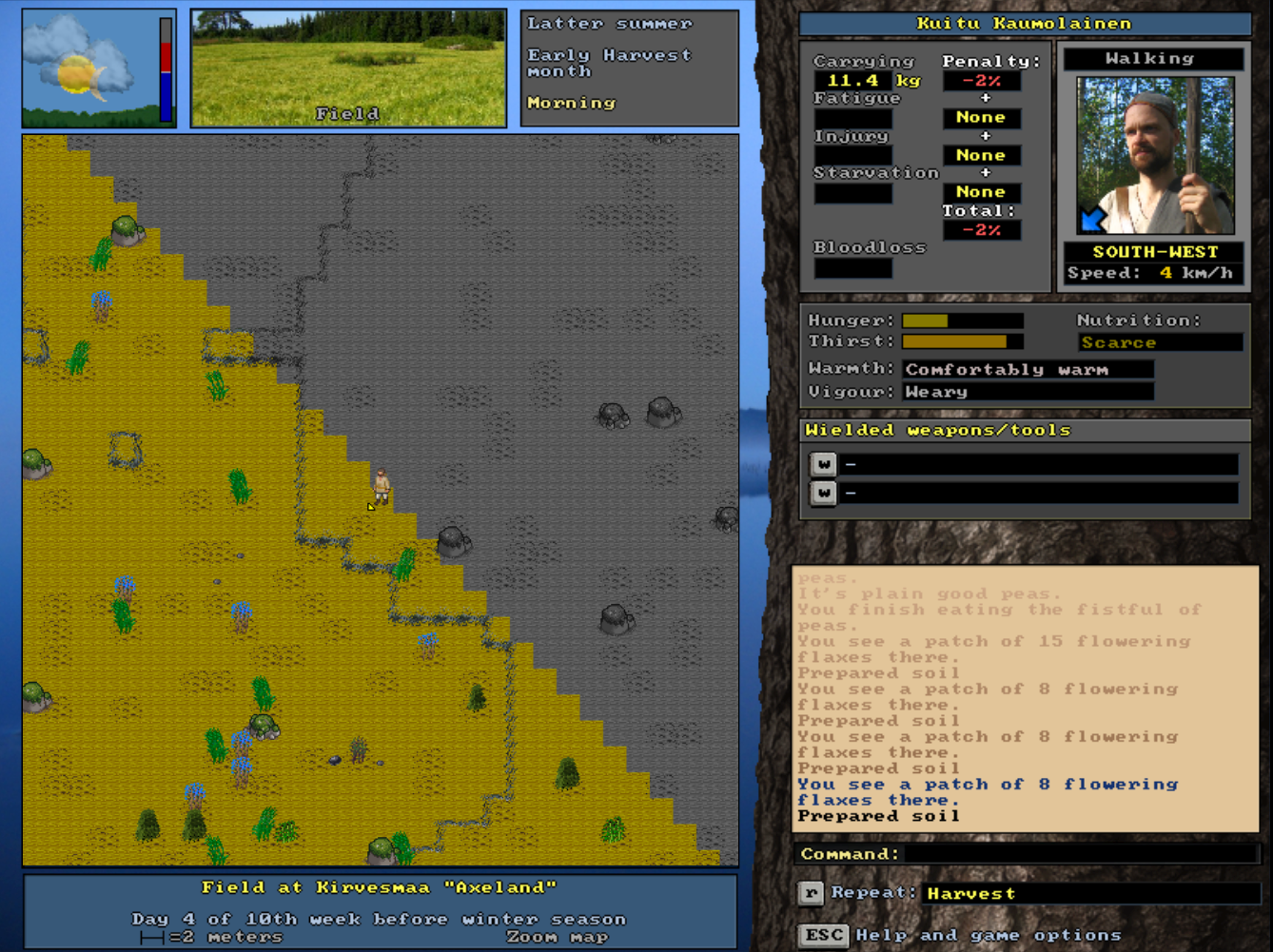 Kuitu Kaumolainen has found his way to Kiesse, a region where flax is grown. At Kaumo where he's from they only produce nettle or hemp fibres. Blue flowering flax is easily spotted from the field, and it could be harvested for fibre already. Textilecraft options Processing plant fibres into yarn involves several stages of work, and it's all done by using your TEXTILECRAFT skill. Character's expertise in textilecraft affects to required working times and the amount of usable fibre or yarn produced. After the plants are harvested the fibres must be then separated from the plant's stalks. This process is called "retting", and it is done by soaking the plants in the water for several days. Sufficient soaking time depends on the water temperature, with the warmer being faster. 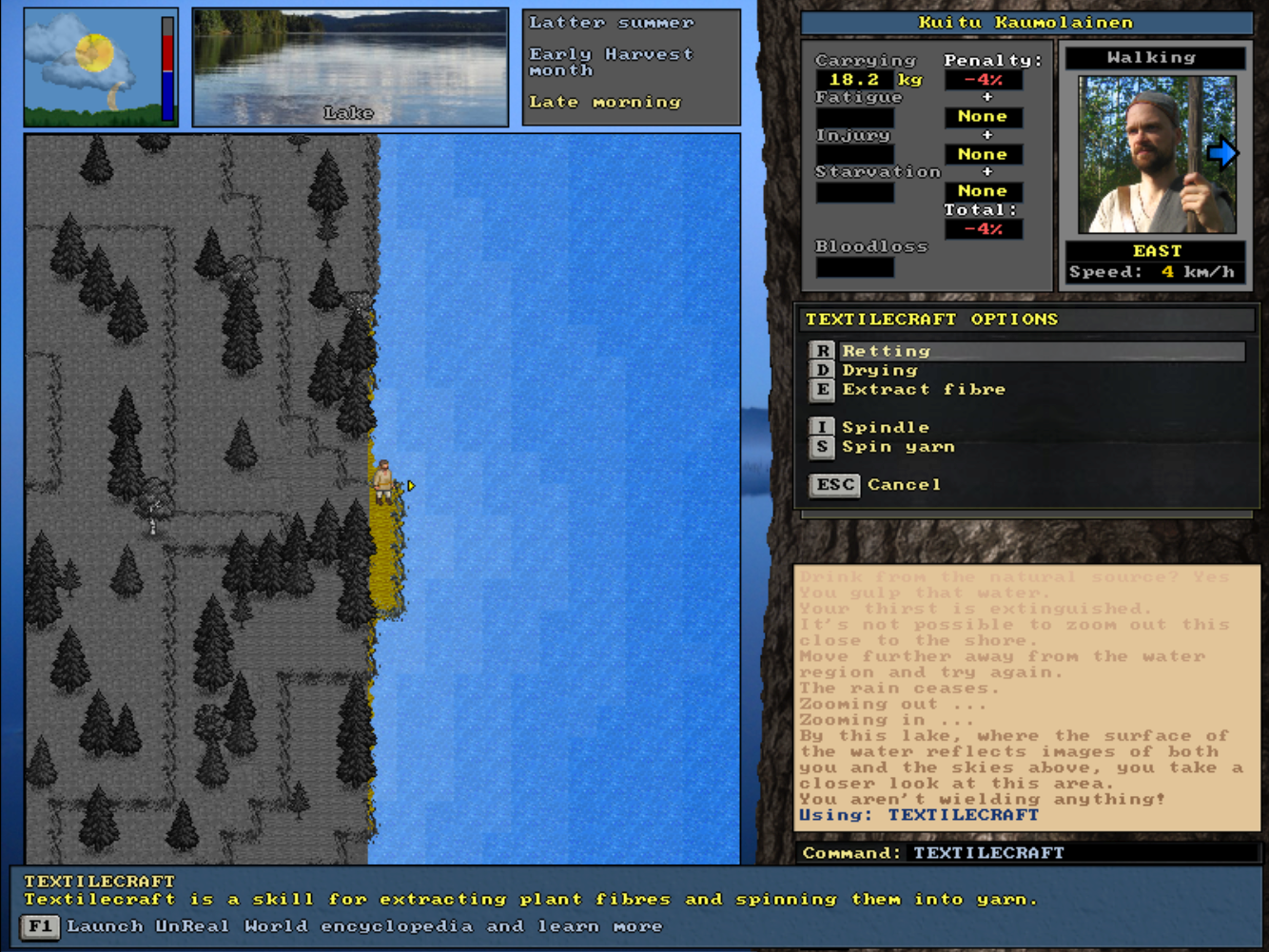 Kuitu Kaumolainen harvested 100 flaxes and headed by the lake to start retting the stalks. Here you can see all the textilecraft options to proceed with fibre extracting and spinning them into yarn. Extracting fibres is hard work It took two weeks for Kuitu's flax to soak properly. After that it took one more week to dry them. And only then Kuitu can start extracting the actual fibre from the stalks. Extracting fibres is done by breaking the dried retted stalks so that the woody core shatters and falls away leaving the loose fibres free. The stalks are beated for example with a club on a solid working surface. Extracting fibres is hard work and commonly carried out with several people working together. Traditionally there has been a custom to arrange specific work parties for processing fibres of each village together with the neighbouring people. And in the game your companions can actually help you with the task. Obtained bundles of fibre are then scraped free from remaining coarse parts. Traditionally special tools were used, but it can be also done by rubbing and whacking the bundles against a hard surface, or with tools at hand. 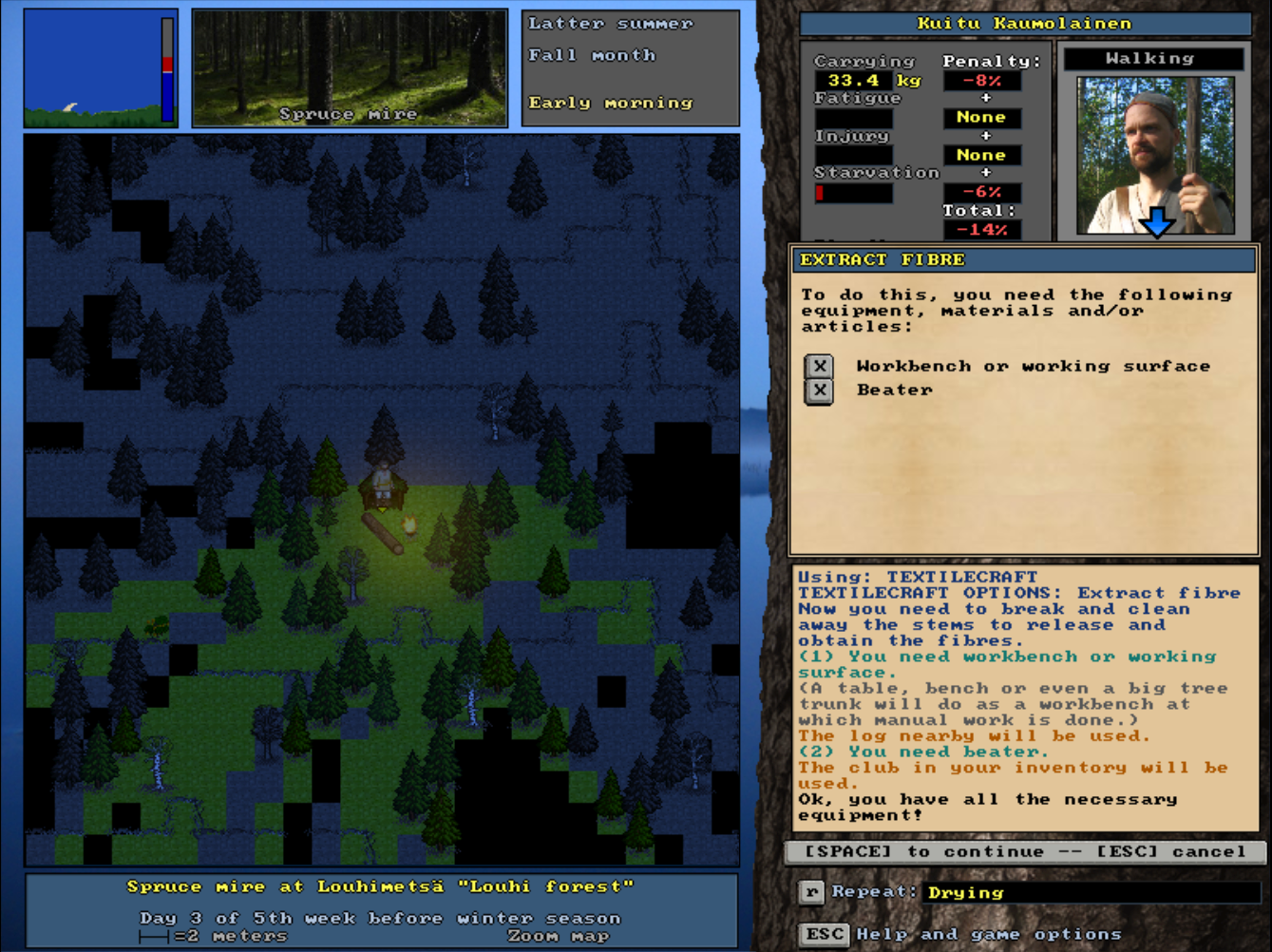 Kuitu starts extracting fibres from the dried retted flax stalks at his shelter. He is about to beat the stalks with a club on top of a log. These dried retted stalks could have been also stored for future and the fibre extracted when there's time and need for that. Spinning yarn It took lees than half an hour to extract the fibres from his 100 flax stalks and Kuitu got 16 bundles of flax fibre. Fibres can be then spun into yarn either by hand, which is slower, or using a spindle. Spindle is also a new craftable item, and very easy to make. So Kuitu crafts a spindle and starts spinning. He decides to go for full length yarn. When starting spinning it is possible to choose how long yarn you wish to spin on one go. 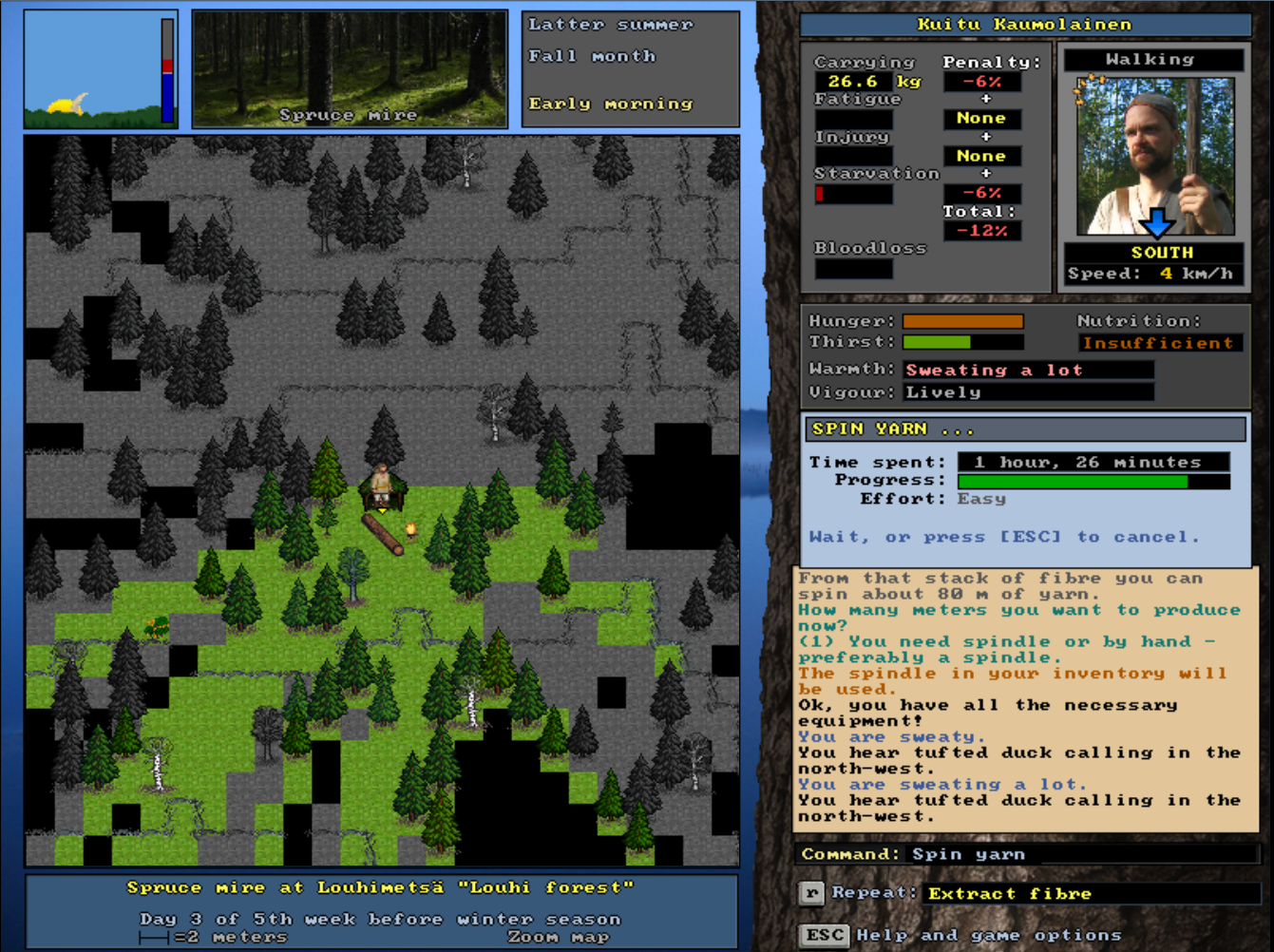 Kuitu manages to spin 80 meters of linen yarn in less than two hours. It could be then used in crafting of different items such as loop snares, arrows - or fishing rods. Nettle specialities In the next version it will be also possible to craft fishing rods, and hooks out of wood or bone. And a working fishing rod naturally needs a line too. Now Kuitu has his linen yarn which could be used as line, but the whole process of extracting flax fibres with retting and drying took weeks. That's quite a long time if there's an urgent need for little piece of yarn. Luckily there's also faster wilderness condition option for utilizing plant fibres - and that is a nettle. Nettle fibres are a speciality as they be extracted directly from the fresh plants without retting and drying processes. To do it you can simply use "extract fibre" option directly to freshly harvested nettles. This method takes more time, but is an useful option when only a small amount of fibre is needed. The nettle stem is crushed by hand, and the fibres carefully stripped off. It doesn't take long before Kuitu finds some nettles. Textile plant harvesting is made possible for fibre even when they are still growing. 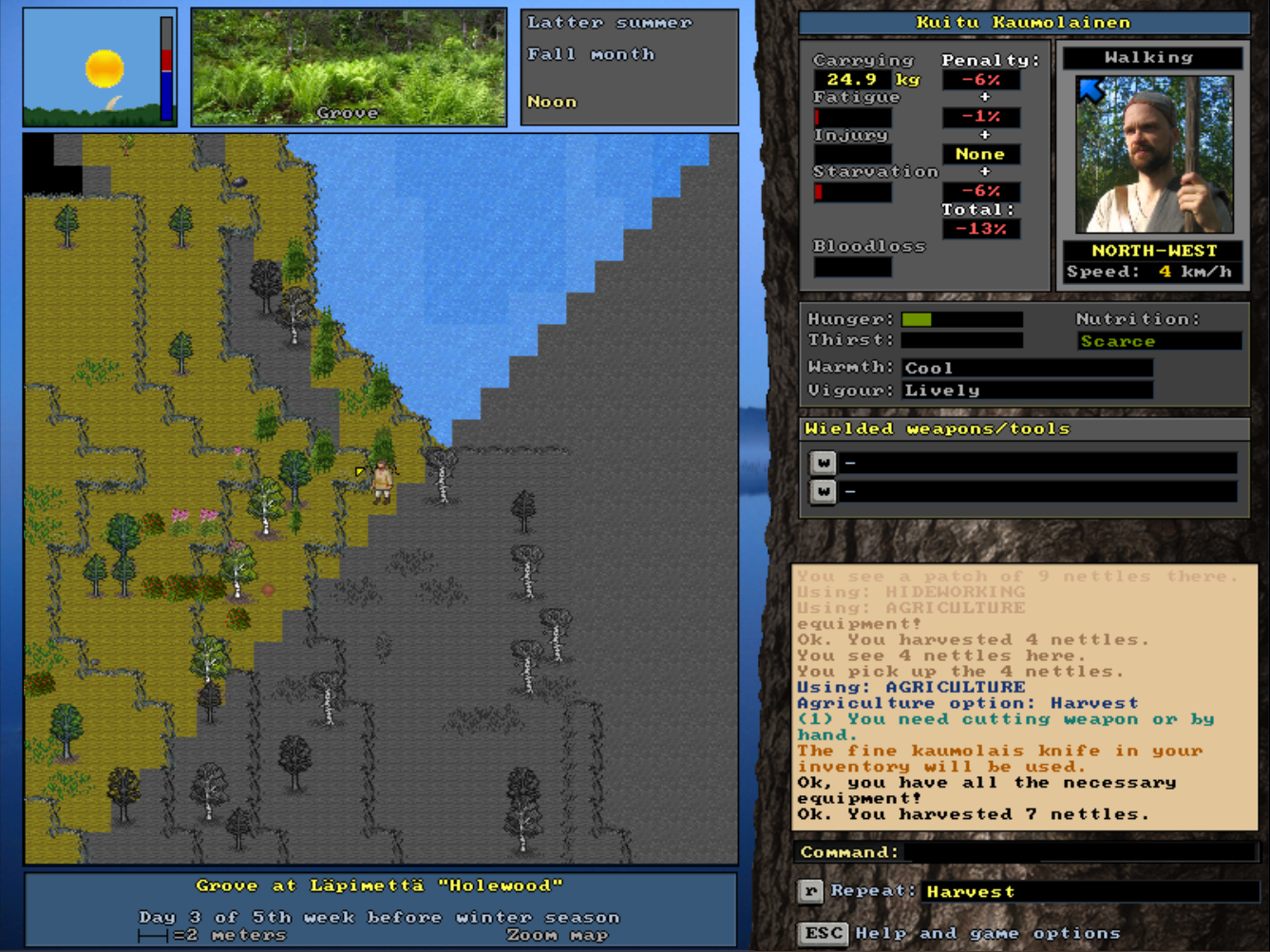 Kuitu harvests some nettles. Then he simply extracts the fibres by hand, and spins some nettle yarn. If he would like to produce a lot of yarn, this would be too slow to be practical, but now he's only after fishing rod line, Wooden hook, nettle yarn - and baits Kuitu finds a slender tree trunk, fashions a wooden hook out of a branch, and proceeds to assemble a fishing rod. Now we should mention that In the upcoming version usage of baits in fishing is also featured. Using baits is not necessary, but naturally highly recommended. Catching a fish every now and then without a bait is still possible, but for reliable rod fishing and decent catches baits are now quite essential. You can use pretty much every food item as a bait and portion of the selected item will be used during the fishing attempt. Pieces of raw meat and fish can be considered decent baits for predatory fish, but for example crumbs of bread may also work for some fish. You can also use a whole small fish, eg. roach or perch, in order to attract a bigger predatory fish. With this addition in effect the type of fish caught with rod fishing is now more dependant on the baits used. It's not likely that you'll catch a pike with an empty hook, but having a small roach as a bait might work. And that little roach might have been caught with quite moderate bait such as bread crumb, or even with some tasty vegetation. 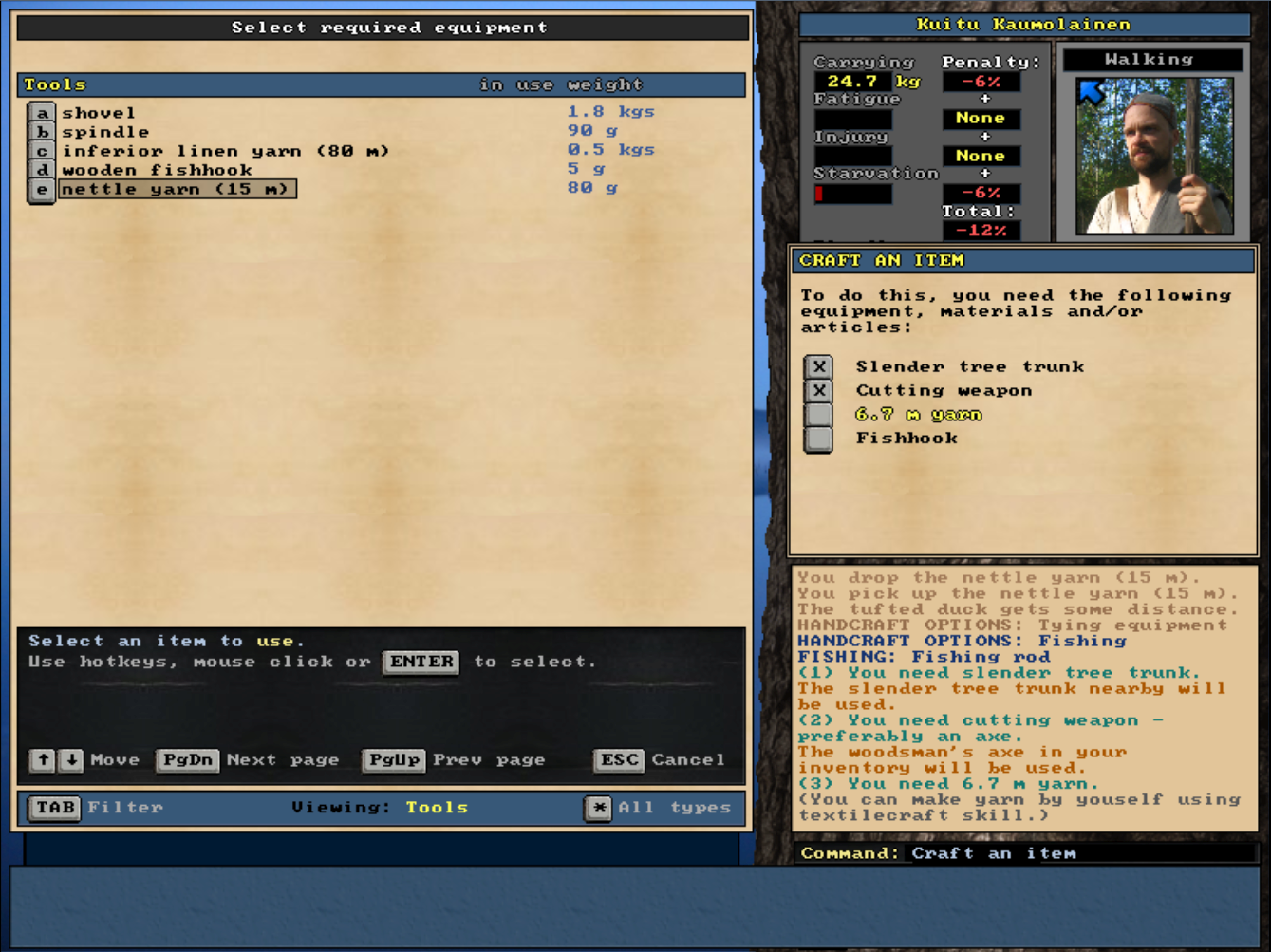 Kuitu makes his survival fishing rod, with a wooden hook and nettle yarn. The work with the several less laborous features continues but we're getting closer to release every day. It's always quite impossible to say when everything is completely wrapped up and working, but maybe - just maybe - we might have this version out in june. Cheers! For those who are more curious about the real life practises here's a short documentary in Finnish showing how the flax is processed. Having read the above I trust you will understand what is happening even without subtitles. The gear used differs slghtly from the more primitive method of the game, but the steps are the same; sow, harvest, ret, dry, extract, spin. https://www.youtube.com/watch?v=TNFD_CUlxZU May 11, 2021, 03:52:38 PM |
1 |
Re: How did you discover UnReal World? -- 10 choice poll
Okay, it is a little over a year I first found this game so I wanted to write my story about it.  I've always liked survival games, mostly played arcadey games like Don't Starve, Minecraft and so on. At the end of 2019 I've become interested in indigenous cultures and survival skills. While I was doing little projects of mine, I wanted a deeper and more realistic survival game too. I remember exactly searching "Hunter gatherer sim" in google. Led me to a reddit post which one user was suggesting Unreal World. It was a indie game subreddit If I remember correctly. To be honest, I was kind of dissapointed at first. I was not expecting a turn based rogue-like game. I watched some videos, saw the devs and how "real" they were about the whole atmosphere of the game. The videos which they have uploaded made me change my opinions about the game and I didn't even try the free version, I just bought it off Steam at full price  (The price was very pocket friendly for my currency even at full). And later I bought one for my friend at sale. Now I don't even look back as I stray further away from video games, URW became the only game I still play and it is the only game which I actually joined its community. I first joined because I wanted to try some mods, but after seeing the other users were pretty chill overall, I decided to join. (The price was very pocket friendly for my currency even at full). And later I bought one for my friend at sale. Now I don't even look back as I stray further away from video games, URW became the only game I still play and it is the only game which I actually joined its community. I first joined because I wanted to try some mods, but after seeing the other users were pretty chill overall, I decided to join. I don't really know why but URW is really a special game for me, the theme the message in the outro everything is just perfect. Thank you Sami and Erkka for this amazing game. May 12, 2021, 12:45:20 AM |
1 |
|
Version 3.72 (beta) for Windows - a surprise release
Surprise, surprise! The autumn has come, and there's hint of winter in the air. The nights have gotten darker and longer, and there's been rainy days too. Perfect weather for coding, one might say. And you know what, that's what's been happening in the silence of the coding chambers lately. So here we are, flexing our coding and release muscles with a little surprise release packed with a dozen of new features and a fistful of fixes. Version 3.72 beta is now available at Steam, Itch.Io and for lifetimers. For the time being there's only Windows version available, but OS X and Linux versions and more features will follow in time. You'll find the full changelog later in this post, but let's highlight some new features first. Random character names 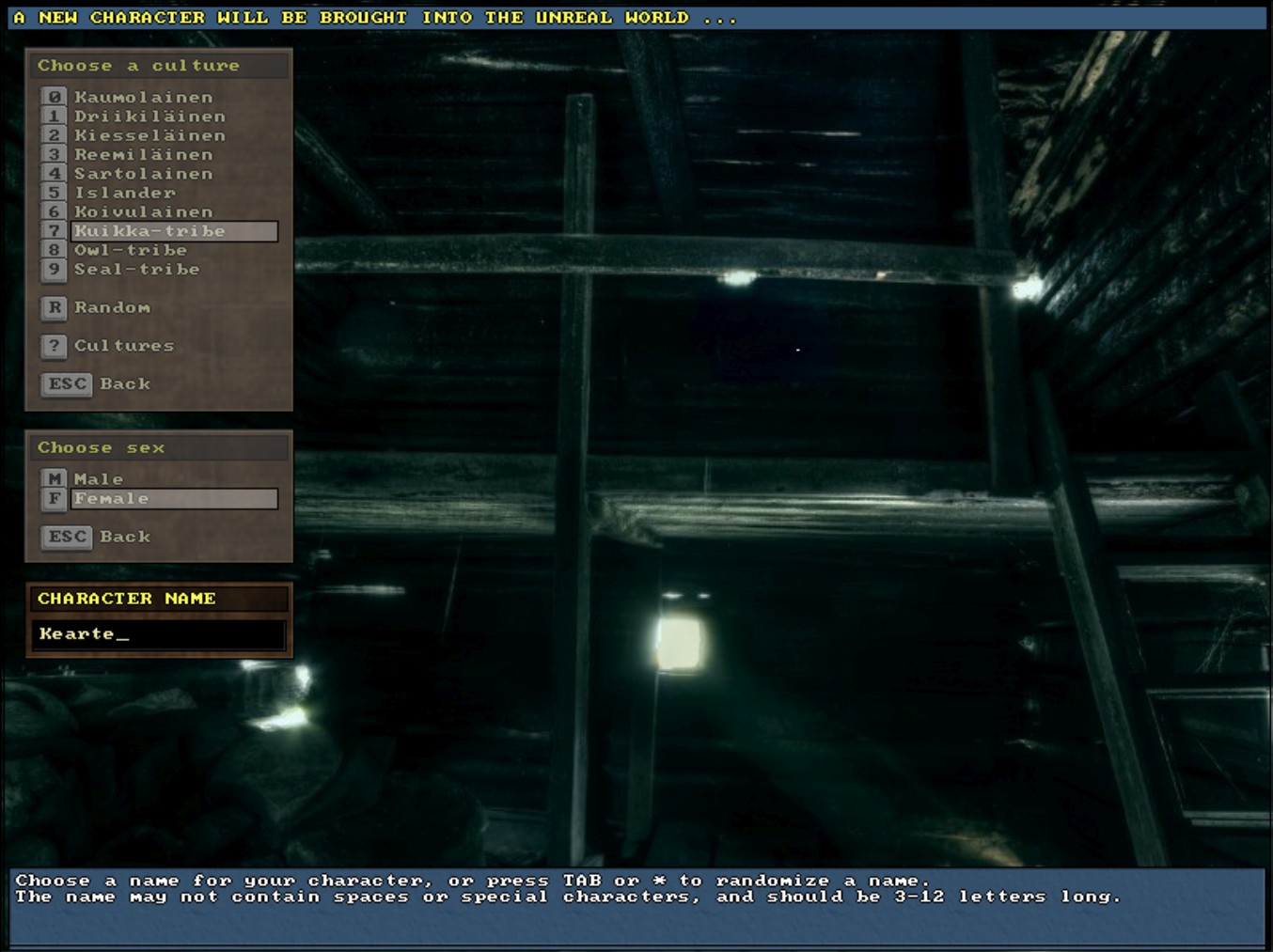 Upon character creation you can now randomize culturally relevant names for them at will. Here a Kuikka-tribe female is being created with a random name of her culture. Harvest and pick agriculture option 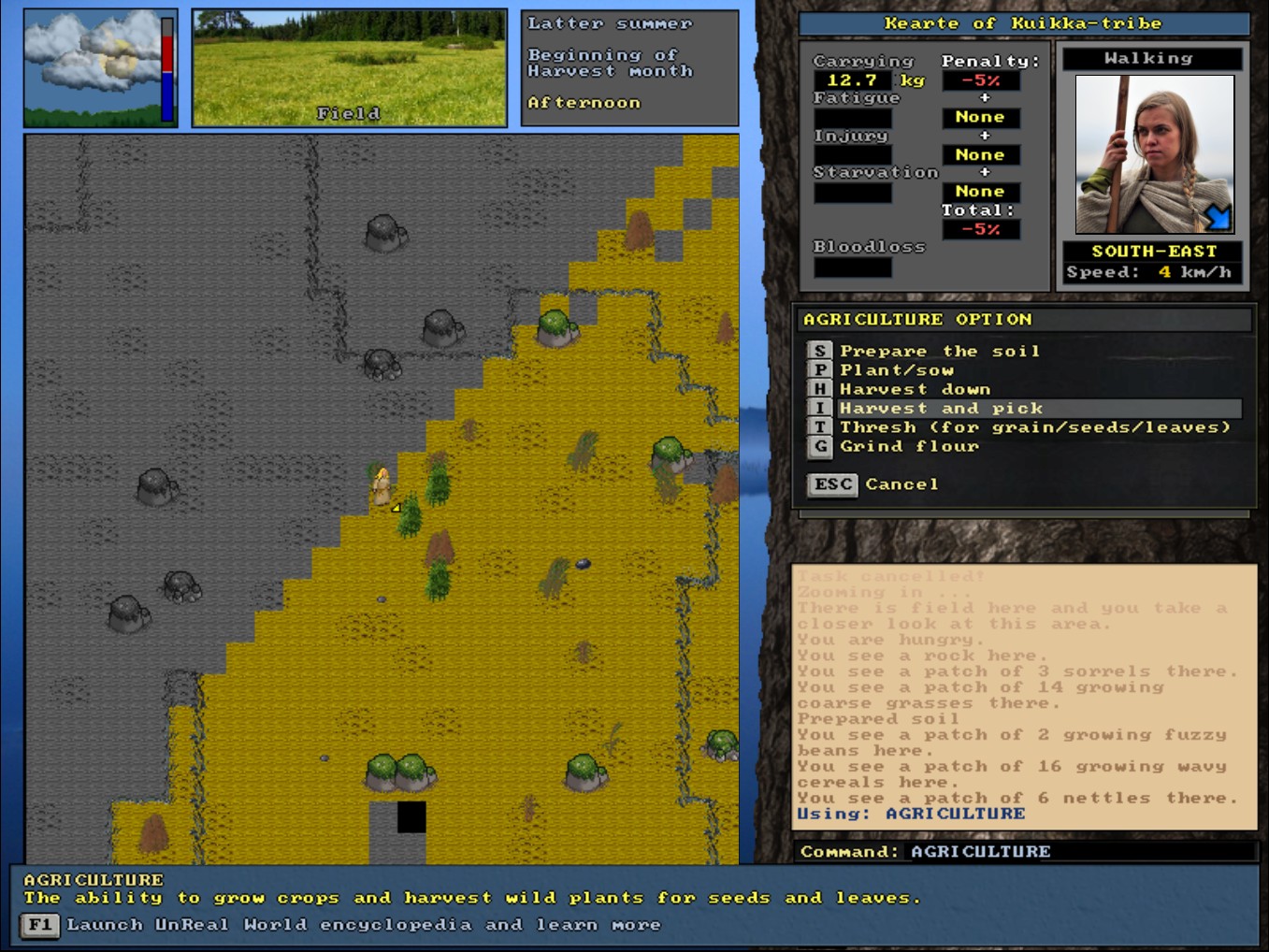 The good old harvest option only cut down the crops, but now there's an option cut and pick the crops to character's inventory at one go. Watercraft marker icons on zoomed-out wilderness map When leaving punt or raft on the zoomed-in map the corresponding marker icon is now shown on the zoomed-out wilderness map. Version 3.72 (beta) changelog - added: random character name option Upon creating characters and choosing their name you can now randomize a culturally relevant names for them. Pressing tab or asterisk (*) will bring up random names which you can then confirm with enter, or modify at will. - changed: name/sex/culture character creation selections order -> culture/sex/name As the random character name option needs to know the culture and sex to pick up a relevant names these selections now come before choosing the name. - changed: "quick and easy" character creation mode now randomly chooses also the culture and sex Previously there was no randomization in that regard, but Kaumolais male was always chosen. Otherwise this character creation mode mode remains the same assigning rest of the options automatically and starting nearby a village. - added: "Harvest and pick" agriculture option The good old harvest option only cut down the crops, but this newly added option also automatically picks up the harvested plants to character's inventory. For clarification the existing "Harvest" option is now renamed as "Harvest down" in the Agriculture menu. - added: domestic animals in the villages will withdraw from player character's way Moving towards a domestic animal will now make it to withdraw from your way. This is to prevent the character from getting jammed eg. in small buildings with village dogs. - modding: increased maximum number of character portraits in each category up to 250. - added: watercraft marker icons on zoomed-out wilderness map When leaving punt or raft on the zoomed-in map the corresponding marker icon is now shown on the zoomed-out wilderness map. - enhanced: message about the markers at wilderness location Instead of given information about each marker with their own message now a summary of all the markers is given in one sentence. For example: "There is a shelter, set traps and a punt at this location." - added: confirmation to start a fire on some occasions You will be asked a confirmation to start a fire in the following conditions: 1. There are valuable items to be burned down where you are about to build a fire. 2. You are building a fire indoors at other than fireplace location. These confirmations will prevent the unfortunate cases of accidentally setting your house or valuable belongings on fire. - adjusted: party members fire making safety checks From now on your companions won't ever start a fire at a location with items on the ground. Previously they might accidentally set a pile of items on fire. - enhanced: rendering of the portraits Character portraits are now rendered directly to the screen using the available resolution. This makes the portraits appear more crisp and clear. This enhancement affects to various game screen where portraits are being used; quest info display, list of ancestors, character profile, chat screen, etc. - SDL update: updated to newest SDL 2.24.0 Updated SDL release includes a good deal of bugfixes which may have hampered some systems. - fixed: sacrificing food in a container mistakenly removed the container too - fixed: auto-cut yarn weights calculated wrong This bug manifested itself eg. in smoking and drying cookery recipes. After retrieving the auto-cut yarn you found it heavier than expected. - fixed: extracting fibre from retted but not dried nettles was possible - fixed: carried weight statistics not updating immediately after cancelled crafting - fixed: character's height in metric units displayed wrong This was a conversion issue within character profile screen. - fixed/adjusted: squirrels won't climb to safety in saplings Previously they were mistakenly considered being high up in a tree even if it was a mere sapling. That's all, dear adventurers. Cheers and enjoy the surprise! And please allow some time for rest of the platforms to follow. You know, my "year-off from coding" still continues 
October 10, 2022, 08:20:43 PM |
1 |


